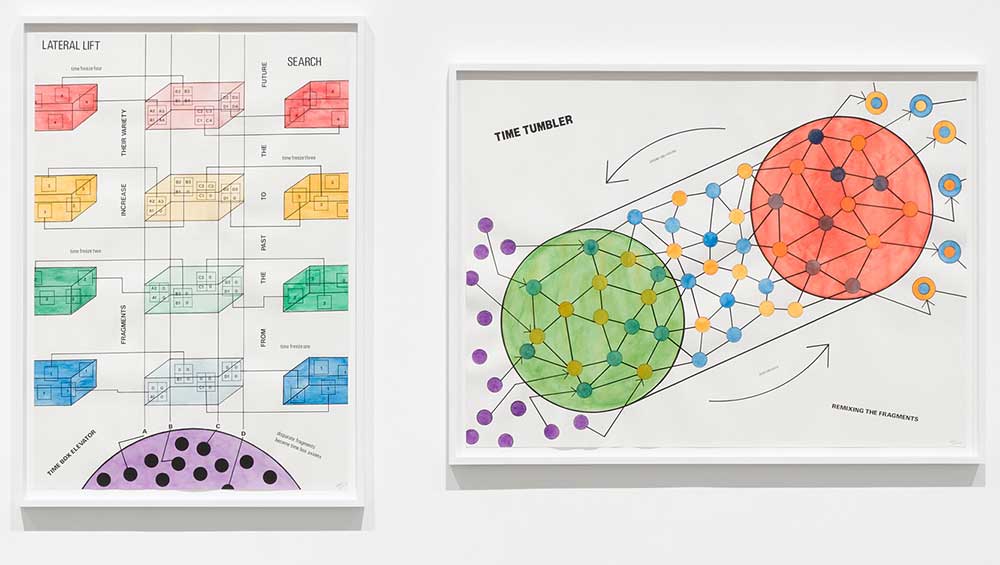
Stephen Willats: Time Tumbler, installation view, Victoria Miro, Gallery I, London, 22 November 2023 – 13 January 2024. © Stephen Willats. Courtesy the artist and Victoria Miro.
Victoria Miro, London
22 November 2023 – 13 January 2023
by BETH WILLIAMSON
As contemporary artists and curators work hard to make art and exhibitions more outward-facing, less self-referential, and actively engaging for diverse audiences, it is worth remembering that the British conceptual artist Stephen Willats, who turned 80 this year, has been ploughing that particular furrow for six decades. Participation, communication, social interaction, active spectatorship and self-organisation are at the heart of what Willats does in a multimedia practice that draws on a broad range of fields of inquiry including cybernetics, advertising, artificial intelligence and behavioural theory. It is no surprise to learn that some of the first visitors to this exhibition were sociology students. Willats’ modus operandi is one that sees the artist embedded within the societal structures they reference. This model, which has been referred to as a machine learning system, is one that is both built by and instigates social interaction and has the artist’s community-based projects at its core.
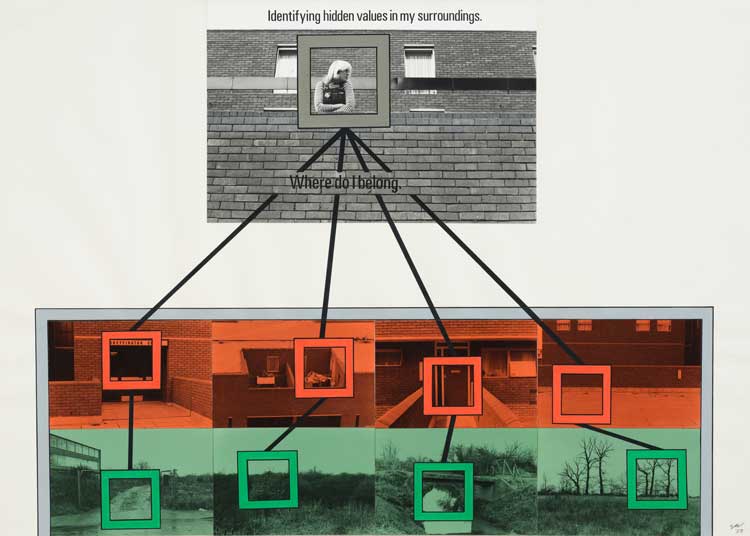
Stephen Willats. Where Do I Belong, 1978. Photographic prints, photographic dye, gouache, ink, Letraset text on paper, 64 x 90 cm (25.22 x 35.46 in). © Stephen Willats. Courtesy the artist and Victoria Miro.
As an exhibition, Time Tumbler presents the chronological extremes of Willats’ career – wall works from the 1970s and recent work made by the artist in the last five years. In the 70s, he devised what he called “neighbourhood projects” in discrete areas of London, Nottingham and Edinburgh. These projects engaged with people in their domestic or work environments, developing over a period of weeks with the intention of uncovering and illuminating the varied and shared stereotypes, perceptions and hopes of their inhabitants. Working closely with the people who populated his chosen environment, Willats used interviews, tape recordings and photography to document these ephemeral projects, documents that then became the building blocks for his, often multipanelled, photographic collages. Ten of these projects, from 1974 to 1980, feature in this exhibition. Often, these works provoke the viewer with prompts that ask them to examine their own perceptions and responses as they move physically and cognitively along the length and breadth of these multipanel works. These images, or groups of images, are constructed from an amalgamation of materials, including photographic prints, gouache, ink and Letraset text, and evoke a linear or sequential model of time.
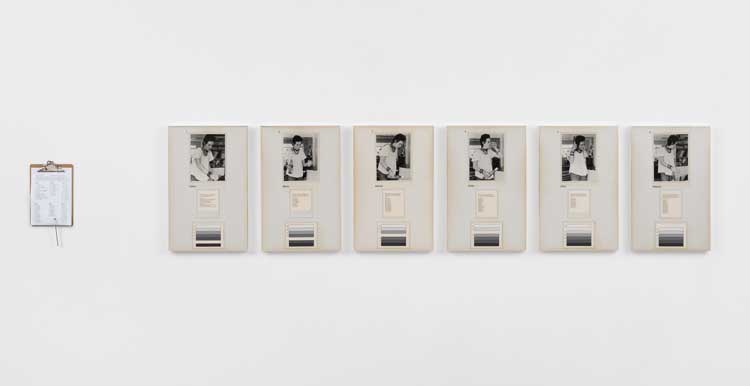
Stephen Willats. A Moment of Action, 1974. Photographic prints, gouache, ink, typed text, Letraset on card, framed with perspex, six panels, each panel 64.5 x 41.3 x 3.5 cm (25 3/8 x 16 1/4 x 1 3/8 in). © Stephen Willats. Courtesy the artist and Victoria Miro.
In A Moment of Action (1974), a woman is shown across six panels in the process of pouring and consuming a drink. Each panel is labelled and viewers are given a list of phrases, or variables, and ask to select the one that best describes the situation. The images are staged and together form a symbolic model of the activity of meeting someone and forming judgments. As co-curator Jelena Kristic understands it, the work “acted as a learning model of pluralism to envision different ways the world could be”.1 In Trying to Forget Where We Came From (1977), interior and exterior worlds vie for our attention. Conscious and counter-conscious narratives are given equal weight, with the viewer left to consider their own interpretation of events.
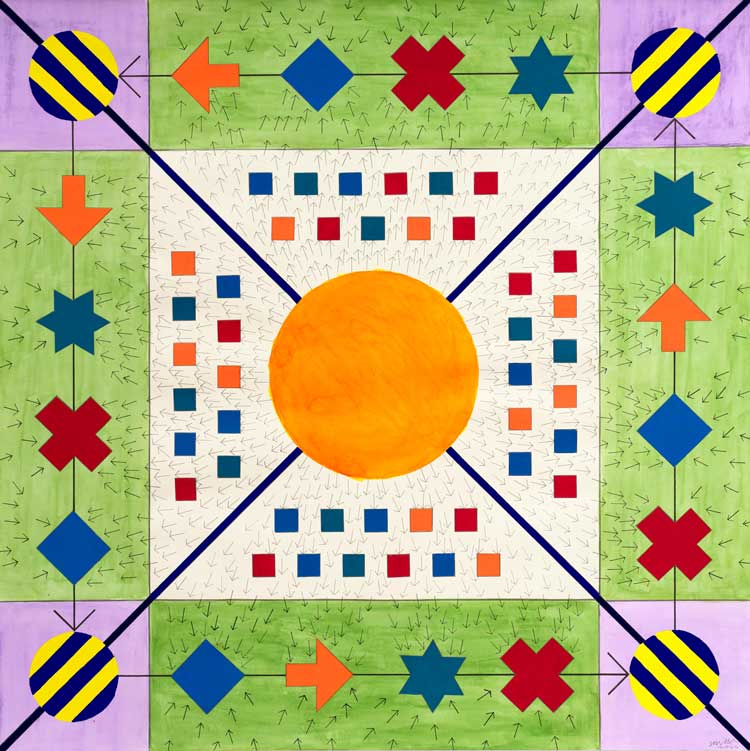
Stephen Willats. Omni Directional Search Engine Drawing No. 9,
2020. Watercolour, pencil, and ink on paper, 100 x 100 cm (39 3/8 x 39 3/8 in). © Stephen Willats. Courtesy the artist and Victoria Miro.
Recent works by Willats develop the ideas he incubated in the 70s. In these newest works, the artist invokes his “time tumbler” model of his longstanding inquiry into how we can alter our perception of reality and make self-determined decisions. The idea of the time tumbler as initially conceived by Willats was further developed in 2020 when he consulted on a project at the British Museum in London. He regarded the museum as a “time box” where objects were trapped (institutionally and architecturally) and cut off from the convolutions of everyday life. Developing a mode of time travel that would allow for speculative navigation of past, present and future, Willats came up with idea of a time tumbler, or time machine, that would free objects from the museum and scramble or reorder fragments of everyday life.
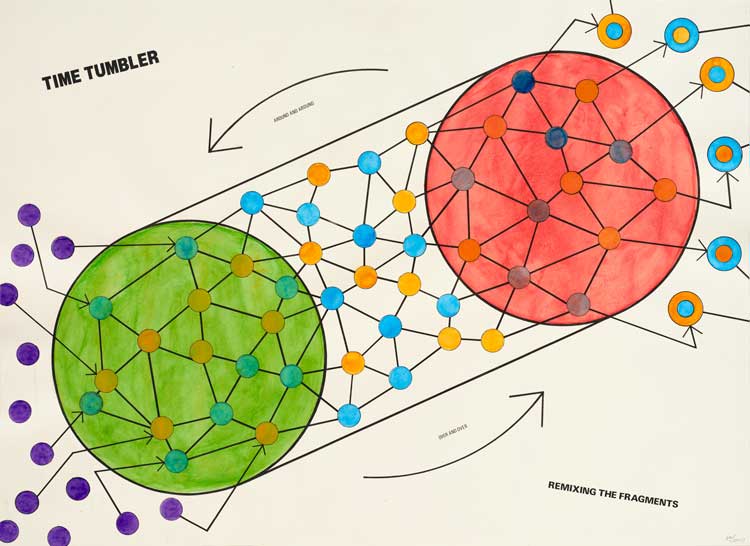
Stephen Willats. Re-mixing the Fragments, 2020. Watercolour, ink, Letraset text on paper, 80 x 110 cm (31 1/2 x 43 1/4 in). © Stephen Willats. Courtesy the artist and Victoria Miro.
Although his time machine has never been realised, his drawings and ideas appear in the diagrammatic works such as Remixing the Fragments (2020) and Passing Through the Time Tumbler (2022). Here, time is no longer linear. Instead, works are now omnidirectional and gesture to a sense of the infinite, something that is reflected in the bright multicoloured palette the artist uses in these diagrammatic works, sometimes including the entire colour spectrum in a single image. There is a real sense of continuous movement in the Omni Directional Search Engine Drawings as massed arrows form multiple flow patterns between and around boldly coloured geometric shapes. These are all arranged within, or around, a circular motif of one sort or another so that flows also tend to generate a strong sense of circular movement, movement that might suck us in with its vortex-like pull, or, alternatively, expel us with its force.
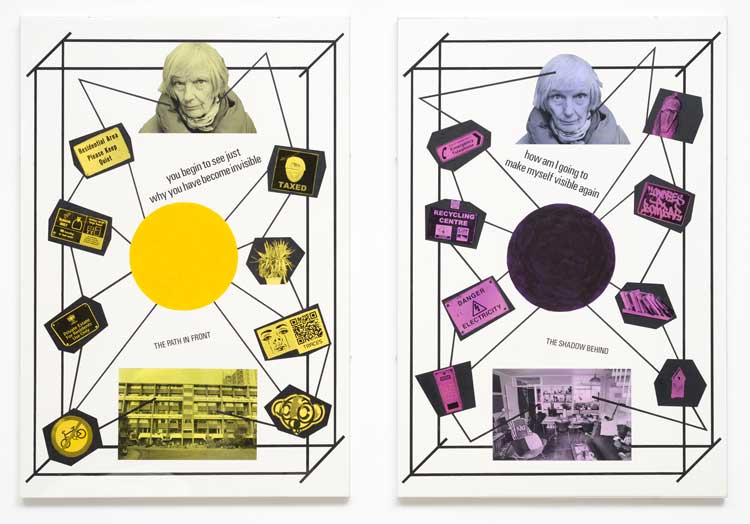
Stephen Willats. The Path In Front and The Shadow Behind, 2022. Photographic prints, photographic dye, acrylic paint, Letraset text on card, framed with perspex, two panels, each panel 105 x 72 cm (41.3 x 28.3 in). © Stephen Willats. Courtesy the artist and Victoria Miro.
Other recent works such as Inside the Time Box (2023) and The Path in Front and The Shadow Behind (2022), despite their bold use of colour, are visually much closer to the works of the 70s. Kristic’s summation is: “Willats’ re-creation of this earlier visual language in his recent ruminations on time aptly instantiates the remaking of oneself summoned by the time tumbler and the interrelated and metamorphosing forms of his practice over the past 65 years.”2 Of course, in the two examples mentioned, the focus is on the place and plight of a single subject in society rather than the community context he commonly addressed in those early works. In essence, Willats’ work represents a social state or condition, as well as the vicissitudes of the social relationships therein. What is surprising, perhaps, is that his clean graphic and conceptual approach belies the sudden moments of empathy that arise in this exhibition. Yet, it is the human condition that is at the heart of Willats’ work, how we communicate, how social structures impinge on our lives, how we see ourselves and others, and how we navigate our everyday lives. Once you realise that, empathy is not so surprising after all.
References
1. Jelena Kristic. In Stephen Willats: Time Tumbler by Bronaċ Ferran, John Kelsey, Jelena Kristic and Stephanie Willats, published by Victoria Miro, 2023, page 55.
2. Ibid, page 68.